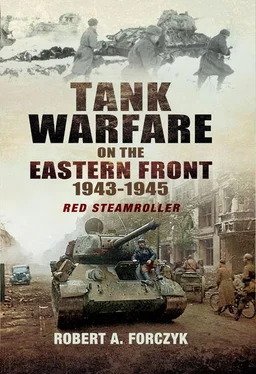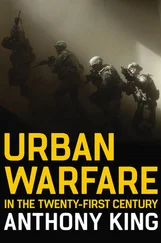Hoth’s PzAOK 4 and Kempf’s forces overwhelmed Vatutin’s first line of defence and pushed hard against his second line, but Soviet resistance was much tougher than expected. Hausser’s II. SS-Panzerkorps enjoyed the most success, advancing to a depth of 28km by the third day of the offensive. In order to prevent the Germans from blitzing their way through the second line of defence, Vatutin was forced to deploy his reserves quicker than expected and he directed Katukov’s 1 TA to assist in blocking XXXXVIII Panzerkorps on the Pena River with its 6th Tank Corps and 3rd Mechanized Corps. Katukov’s armour was committed to the infantry support role – unusual for an entire tank army. Katukov was not happy about this since he wanted his armour kept massed rather than parcelled out to support various rifle divisions, but did as ordered. Vatutin and his subordinates were also shocked by the appearance of the Panther tank – of which Soviet intelligence had been unaware – as well as the unusually large number of Tiger tanks being used by Hoth’s PzAOK 4. {94}
On 6 July, von Knobelsdorff’s XXXXVIII Panzerkorps reached the 6 GA’s second line of defence along the Pena River and was surprised to find that steep banks and swampy terrain made it impossible for tanks to cross. {95} Furthermore, Katukov’s tanks and the remaining infantry from 6 GA were on the far side of the river, ready to counter-attack any crossing attempt. In modern terms, this ignorance of terrain would be termed a failure of intelligence preparation of the battlefield. Unable to cross the Pena, the XXXXVIII Panzerkorps was forced to shift its axis of attack eastward toward Dubrova in order to get around the Pena River obstacle and to protect the flank of II.SS-Panzerkorps. Katukov responded by positioning General-major Semen M. Krivoshein’s 3rd Mechanized Corps (3 MC) in the vicinity of Dubrova, between Hoth’s two Panzerkorps, and shifting General-major Andrei L. Getman’s 6th Tank Corps to protect the eastern end of the Pena line. Krivoshein was one of the most experienced tankers in the Red Army but he had been stuck in Moscow as head of training for GABTU for the past two years. Oddly, when Katukov visited Krivoshein’s command post near Dubrova, he found that Krivoshein had his wife in the field with him. {96} In any case, when XXXXVIII Panzerkorps lunged toward Dubrova on 7 July, it ran straight into Krivoshein’s 3 MC.
Hausser’s II.SS-Panzerkorps had another very good day on 6 July, continuing its drive toward the northeast. As Valeriy Zmulin noted, ‘the breakthrough on 6 July is especially impressive: in just eight hours of time, the SS divisions had managed to advance approximately 20km into the defences of a front that had several months in preparation.’ {97} Stalin was sufficiently alarmed by Hausser’s rapid advance that on the evening of 6 July he agreed to Vatutin’s request to release Rotmistrov’s 5 GTA from Steppe Front and move it up to support a major counter-attack against Hoth’s armour. He also released the 10th Tank Corps from Steppe Front and transferred it to Katukov’s 1 TA. In order to slow down Hausser, Vatutin tried mount a coordinated armoured counter-attack using General-leytenant Andrei G. Kravchenko’s 5th Guards Tank Corps, Polkovnik Aleksei S. Burdeiny’s 2nd Guards Tank Corps, plus the newly-arrived 2nd Tank Corps (General-major Aleksei F. Popov) and the 10th Tank Corps (General-major Vasily G. Burkov) against the eastern flank of Hausser’s penetration. However, this proved far too difficult to execute since Vatutin allowed only eight hours for planning and two of the tank corps were just arriving in this sector. {98} Instead of a simultaneous effort, the Soviet tank attacks began early in the morning and continued until noon, in a series of piecemeal attacks. By sheer luck, Burkov’s 10 TC attacked the tip of the German salient just when most of LSSAH ’s and Das Reich ’s armour was advancing westward to support XXXXVIII Panzerkorps, leaving the 29km-long eastern flank vulnerable. However, around 0920 hours the lead Soviet brigade ran into two damaged Tigers that had been left to watch the road to Prokhorovka. Although barely mobile due to mine damage, SS-Unterscharführer Franz Staudegger’s Tiger could still shoot and he had a field day, picking off 22 Soviet tanks. {99} Burkov’s attack fizzled out, even though Staudegger’s Tiger had exhausted all its ammunition and the rest of LSSAH ’s armour was not in a position to block this attack.
Most of the Soviet counter-attack on 8 July was focused against Das Reich ’s extended flank. The Das Reich had temporarily shifted to the defensive here, holding the line with both its Panzergrenadier-Regiments and 12 StuG-IIIs, while the division’s armour was pushing westward. Kravchenko’s 5 GTC was the only attack that was preceded by an artillery preparation and some Il-2 Sturmovik sorties and it achieved the most success; around 1130 hours Soviet T-34s were able to overrun some of SS-Panzergrenadier-Regiment Deutschland ’s positions. However, Kravchenko received no help from the Soviet corps, which were not yet ready to attack. SS-Panzerjägers shot up a number of tanks and the German artillery separated the Soviet tanks from their supporting infantry. After two attacks were repulsed, Kravchenko fell back to regroup after losing 31 of his tanks. {100} Officer casualties were particularly heavy in Kravchenko’s 5 GTC, with two regimental commanders killed and another wounded, plus three-quarters of the battalion commanders. Popov’s 2nd Tank Corps did not even begin to attack until after 1300 hours and then without artillery support. Popov’s tankers not only had no information on the enemy’s dispositions but they ran into Soviet minefields, causing casualties. Attacking with two tank brigades up front and the third in support, inadequate planning quickly caused Popov’s attack to fall apart and part of one brigade managed to get lost and another fired on friendly troops. Popov’s weak, uncoordinated armoured jabs were easily fended off by Das Reich . Burdeiny’s 2 GTC was the most unfortunate, since it was detected by the Luftwaffe and Schlachtgeschwader 1 (Sch. G 1), equipped with the HS-129 tank-busters, was sent en masse to attack it. The HS-129B-1 was fitted with the 3cm MK 103 cannon, firing high-velocity APCR ammunition, which could penetrate a T-34’s thin upper surface armour. Attacking at low-level, the HS-129 aircraft inflicted considerable damage upon 2 GTC, knocking out about 50 tanks against two planes shot down. {101} This was a historical moment in armoured warfare – the first time that aircraft had single-handedly broken up an enemy tank formation. However, some of Burdeiny’s tanks did reach Totenkopf ’s lines late in the day and enjoyed one singular success. SS-Sturmbannführer Eugen Kuntsmann, commander of SS-Panzer-Regiment 3, decided to conduct a personal reconnaissance in his Befehlpanzer (command tank) to determine where a group of Soviet tanks had appeared and he ran into a Soviet anti-tank ambush. His tank was hit twice and he was killed in action. {102} Vatutin was responsible for the botched Soviet armoured counter-attack on 8 July, which missed an opportunity to knock II.SS-Panzerkorps off balance. On the other hand, Hausser’s corps survived a major Soviet armoured counterstroke against its vulnerable eastern flank, but the threat remained and it was still devoting more effort to protecting its flanks than advancing toward Kursk. Furthermore, the diversion of much of the armour of the LSSAH and Das Reich to assist the XXXXVIII Panzerkorps’ stalled advance against Katukov’s 1 TA had achieved nothing useful. Increasingly, the German Panzerkorps were forced to divert more and more of their strength away from the Schwerpunkt in order to protect their flanks. Nor did Hoth have any reinforcements to give to Hausser, so the shortage of infantry was proving more inimical to the German advance than tank losses. Consequently, only parts of each Waffen-SS division were still capable of advancing and much of Hausser’s corps had essentially shifted to a tactical defence. Hoth did provide two infantry divisions to assist in protecting Hausser’s flanks – the 167. and 168.Infanterie-Divisionen – but both failed utterly. German infantry simply could no longer advance and hold ground when opposed by large Soviet armoured formations.
Читать дальше








![John Stieber - Against the Odds - Survival on the Russian Front 1944-1945 [2nd Edition]](/books/405234/john-stieber-against-the-odds-survival-on-the-russian-front-1944-1945-2nd-edition-thumb.webp)



